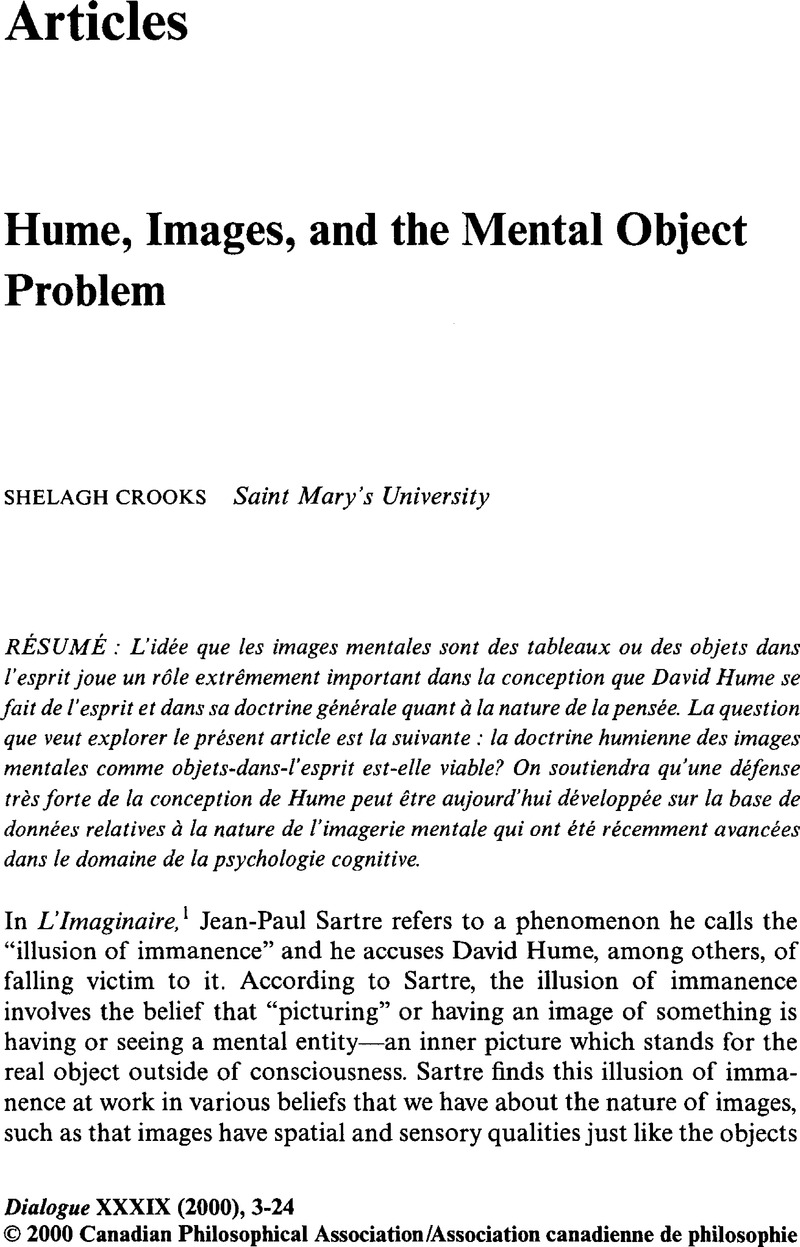No CrossRef data available.
Published online by Cambridge University Press: 13 April 2010

1 Sartre, J.-P., L'Imaginaire: Psychologie phenomenologique de l'imagination, 29th ed. (Paris: Gallimard, 1948)Google Scholar. In this paper, references are to the pagination of the English translation of L'Imaginaire, by the Philosophical Library Inc., in the Methuen and Co. edition, 1972, entitled The Psychology of Imagination.
2 Ibid., p. 5.
3 Aristotle, On the Soul, 427b19.
4 Aristotle, On Memory and Recollections, 451a19.
5 Hume, David, A Treatise of Human Nature, edited by Selby-Bigge, L. A. (Oxford: Oxford University Press, 1965), p. 1.Google Scholar
6 Ibid.
7 Ibid.
8 Ibid.
9 Ibid., p. 2.
10 Ibid., p. 2.
11 Ibid., p. 8.
12 Ibid., p. 3.
13 Locke, John, An Essay Concerning Human Understanding, edited by Nidditch, P. H. (Oxford: Clarendon Press, 1975).Google Scholar
14 Hume, A Treatise of Human Nature, p. 239.
15 Ibid., p. 235.
16 Ibid.
17 Ibid., p. 239.
18 Hume, David, An Enquiry Concerning Human Understanding, edited by Selby-Bigge, L. A. (Oxford, 1902), p. 151.Google Scholar
19 Ibid., pp. 151–52.
20 Ibid., p. 152.
21 Ibid.
22 Sartre, The Psychology of Imagination, p. 5.
23 In regard to the “discovery” condition, Sartre writes “the image teaches nothing, never produces an impression of novelty, and never reveals any aspect of the object. It delivers en bloc no risk, no anticipation: only a certainty. My perception can deceive me, but not my image. Our attitude toward the object of the image could be called “quasi-observation.” Our attitude is, indeed, one of observation, but it is an observation that teaches nothing. If I produce an image of a page of a book, I am assuming the attitude of a reader, I look at the printed pages. But I am not reading. And, actually, I am not even looking, since I already know what is written here” (ibid., p. 9).
24 Dennett, Daniel, Content and Consciousness (London: Routledge and Kegan Paul, 1969), p. 136.Google Scholar
25 Regarding the relative dependence of the mental image on the intention of the imaginer, Sartre says this: “The object as an image is contemporaneous with the consciousness I have of it, and it is determined exactly by that consciousness: it includes nothing in itself but what I am conscious of … the world of images is a world in which nothing happens. I can at will develop this or that object into an image, make a cube turn, make a plant grow, make a horse run, without producing the least shift between object and consciousness. Not a moment of surprise: the object which is moving is not alive, it never precedes the intention” (Sartre, The Psychology of Imagination, p. 10).
26 Describing the contrast between an immaterial image and a material photograph, Sartre says this of the photograph: “the material [of the photograph] can be perceived for itself. … This photograph, taken by itself, is a thing: I can try to ascertain the duration of its exposure by its colour, the product used to tone it and fix it, etc.” (ibid., p. 17).
Earlier, Sartre is critical of the propensity of psychologists to conceive of the image in spatial terms. He writes: “Most psychologists believe that they find the image when they make a cross-section of the stream of consciousness. For them the image is one element in an instantaneous synthesis, and each consciousness includes or can include one or more images: so that an investigation of the role of the image in the thought process consists of trying to find the place of the image among the variety of objects which constitute a present consciousness; it is in this sense that they can speak of a thought which is supported by images. We now know that we must drop these spatial metaphors. This image is a consciousness which is sui generis, which can in no way form part of a larger consciousness” (ibid., p. 14).
27 Shepard, R. and Podgorny, P., “Cognitive Processes that Resemble Perceptual Processes,” in Handbook of Learning and Cognitive Processes, edited by Estes, W. K. (Hillsdale, NJ: Erlbaum, 1978).Google Scholar
28 Reed, S. K. and Johnsen, J. H., “Detection of Parts in Patterns and Images,” Memory and Cognition, 3 (1975): 569–75.CrossRefGoogle ScholarPubMed
29 Shepard, R. and Cooper, L., “Mental Rotation of Three-Dimensional Objects,” Science, 171 (1971): 701–703.CrossRefGoogle ScholarPubMed
30 Dennett, Daniel, Brainstorms (Cambridge, MA: The MIT Press, 1981), p. 168.Google Scholar
31 Finke, R. and Schmidt, M., “Orientation-Specific Color Aftereffects Following Imagination,” Journal of Experimental Psychology: Human Perception and Performance, 3 (1977): 599–606.Google Scholar
32 Hume, A Treatise of Human Nature, p. 372.
33 Ibid., pp. 60–61.
34 Wright, John, The Sceptical Realism of David Hume (Manchester: Manchester University Press, 1983), pp. 211ff.Google Scholar
35 Perky, C. W., “An Experimental Study of Imagination,” American Journal of Psychology, 21 (1910): 422–52.CrossRefGoogle Scholar
36 Shepard, R. and Chipman, S., “Second-Order Isomorphism of Internal Representations: Shapes of States,” Cognitive Psychology, 1 (1970): 1–17.CrossRefGoogle Scholar
37 I will say in passing, however, that Hume's belief in extended images, which by necessity have shape and location, would seem to fit the stronger, first-order model of isomorphism.